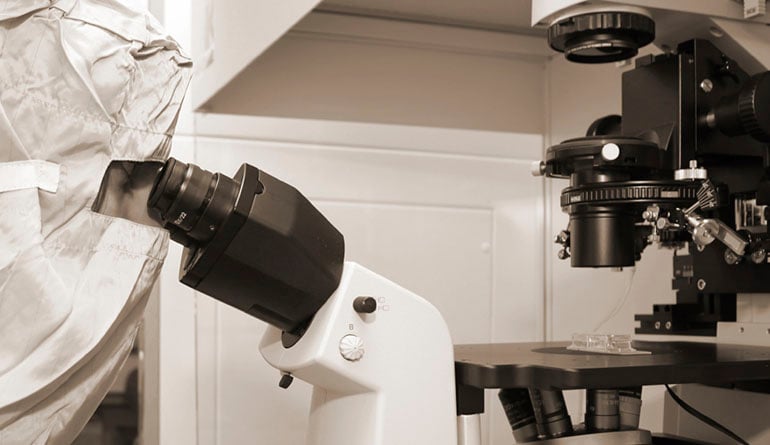
Designers of color microscopy systems face various challenges depending on the targeted application. For many digital microscopy systems, the capture and analysis of color information is critical to meeting the application’s goals. The system’s camera or cameras, which serve as the “eyes” of the system, must be able to provide the right levels of both spatial and color information to enable the software “brain” of the system to perform its function.
Choosing the proper camera technology is a key factor in creating an effective color microscopy imaging solution – regardless of whether the imaging solution is within a larger machine vision application, or it is part of a simpler laboratory-style rig. The first step in making this choice is deciding whether to use a Bayer color camera or a three-sensor prism camera. Your decision can have a significant impact on the image quality of the system. But it will also affect the cost and perhaps the size and other factors, so it is important to carefully consider a variety of factors.
Bayer color technology supports basic system requirements
For systems where the color requirements are relatively modest, a standard single-sensor camera (detector) featuring an imager equipped with a Bayer color filter may provide adequate results. A Bayer camera uses a predefined pattern of red, green, and blue filters placed over the pixels to capture color information. But this means each pixel can only give a true value for one of the three colors. To calculate a full RGB value for any pixel, the software must look at neighboring pixels to estimate the value of the other two colors. This estimation process (called interpolation) tends to make colors duller while also being less accurate. More importantly, it reduces the effective resolution of the camera making small details less clear and subject to certain types of color artifacts such as moiré patterns and color fringes.
If your application has a fairly high tolerance for these sorts of issues, then a Bayer camera can provide a simpler, more economical solution than moving to a prism camera. Of course, even in these cases, one still needs to look for a high quality Bayer option in order to meet the demands of microscopy imaging. That’s why it is important to select a Bayer camera with low noise, good sensitivity and a reasonable frame rate, as well as specialized features like color enhancement and/or color space conversion. Integration with leading microscopy software packages can also be quite important.
Fortunately, Bayer color cameras have improved considerably in recent years, giving system designers many good options for basic color microscopy systems. In particular, new cameras based on state-of-the-art CMOS imager technology provide fast frame rates and deliver low-noise color images that can meet the needs of many applications.
Need some guidance in creating microscopy systems with advanced color capabilities?Download our Tech Guide: Advanced Color Microscopy Solutions, and learn how various camera capabilities can be utilized to meet your application requirements.
Multi-sensor prism cameras for advanced applications
If one is looking to build a more advanced color microscopy system where superior color and spatial performance provides added value to the application, a more advanced camera technology should be considered. When subtle shades of a specific color must be detected, or when small details and edges must be clean and sharp, the muddier colors and lower spatial precision of a Bayer camera might prove to be problematic.
Three-sensor prism cameras (3-CMOS or 3-CCD) use high-grade optical prisms to split incoming light to three separate sensors based on spectral wavelengths (red, green, blue). Compared to the interpolation used by Bayer cameras to estimate RGB values, this provides brighter colors with higher accuracy and better contrast when subtle differentiation is required. It also means there is no loss of resolution, making prism cameras up to three-times better at capturing small details in cell counting applications, semiconductor inspection, and many other microscopy tasks.
In addition, the three-sensor prism technology results in higher effective sensitivity. This is because the Bayer filter matrix essentially blocks 2/3 of the wavelengths falling on each pixel, while prism cameras use their multiple sensors to capture nearly 100% of the light emanating from the sample. With a higher overall signal-to-noise ratio, prism cameras are able to produce better images with lower light levels to reduce the stress on delicate samples.
When precise colors and small details are critical differentiators in a microscopy-based system, the added value of a prism color camera can be essential to achieving success in the marketplace.
Evaluate your options
Often, the only way to figure out the right choice is to test both options. Be sure to pay attention to color accuracy, color differentiation, low-light sensitivity, level of detail, and any other features that are important to your application.
For help with your evaluation, contact the JAI team. We have both Bayer cameras and prism technology, as well as integration with leading microscopy software packages, to offer system builders multiple options for creating microscopy systems with advanced color capabilities.
